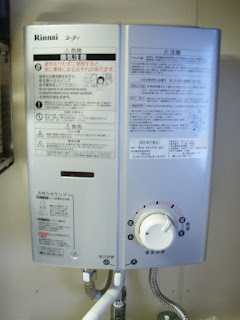Washing Dishes
We had a dishwasher there, we don’t here. I do the dishes after every meal here because we only have four plates, four bowls, three mugs (I accidently broke one), a few storage containers (we don’t need more because the fridge is so small it won’t hold more), some silverware, two pots and a pan. You might say, why don’t we just buy more? The answer is because we don’t have the room to store any more. Well, we do have room for one more mug.
We have some high cabinets that require a chair to reach. I don’t understand why they are so high. Most Japanese aren’t as tall as Ted and I are. We keep extra stuff up there that we don’t need so often.
The water that comes into the kitchen sink is cold only. We have a gas water heating machine mounted above the sink. To get hot water, you have to turn on the gas and turn on the machine. It’s not as convenient as hot and cold running water, but it works.
Washing Clothes
We have this teeny tiny cold water only washing machine here, not a front loading high efficiency machine, like in NC. It only holds a few clothes at a time and you have to put everything in mesh bags to keep the clothes from twisting around and tying in knots.
We don’t have a dryer, which is normal here. In warmer weather, people dry their clothes out on the balcony. Now that it is winter, and below freezing most of the time, we dry our clothes inside, on hangers and these clothes pin hanging contraptions. We are limited in how much we can wash by the size of the washer and by the amount of drying space there is, so I never feel caught up on the laundry. In addition, there are always things hanging around drying, so the house isn’t done being cleaned or straightened up.
Keeping the Floor Clean
We have a main room with a wood floor and three side rooms. Two of the side rooms have tatami mat floors and one room has linoleum. The step up part of the mud room has wood also. |
| Wood floor |
According to wikepedia “A tatami is a type of mat used as a flooring material in traditional Japanese-style rooms. Traditionally made of rice straw to form the core (though nowadays sometimes the core is composed of compressed wood chip boards or polystyrene foam), with a covering of woven soft rush (igusa) straw, tatami are made in standard sizes, with the length exactly twice the width. Usually, on the long sides, they have edging (heri) of brocade or plain cloth, although some tatami have no edging.”
Here’s what ours look like. I like them because it is something traditionally Japanese, but I don’t like them because they’re not so practical. You can’t put anything with legs on them because the legs would poke a hole. Nice for traditional Japanese sitting on the floor, but not so practical for Americans who are used to sitting in chairs.
Bathroom
Bathroom cleaning is pretty much the same, except that I don’t have any Pine-Sol here. Yet. Pine-Sol is my favorite cleaner and they don’t have it at the Haruki. Do you have smells that bring up good memories? Pine-Sol does that for me. If it smells like pine, it must be clean.
The Mud Room
It’s cold and snowy here, so we need lots of coats and boots, as well as all the other winter stuff. Coats and boots live in the mud room, along with skis and poles and gloves and hats and the bag to take to Haruki and cardboard boxes and other miscellaneous things. It needs straightened and organized constantly.
Year of the Dragon
Cleaning is really not so bad here. When I'm not cleaning, I’ve been working on the dragon’s spine. The spine is made up of lines of metallic Soft Twist, couched down with Accentuate – not so exciting as stitching goes, but the dragon is taking shape.
This little Neko-chan eats orts.
Finally, this was our “Christmas tree” this year.












I love your Ort holder!! Thanks for letting us into your new world too.
ReplyDelete